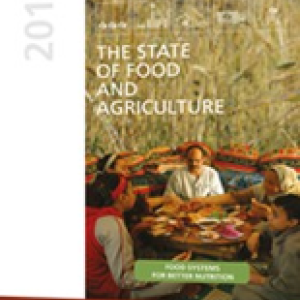
The FAO’s latest food and agriculture series report is on the theme of better nutrition. Focusing on malnutrition in all its forms – underweight, micronutrient deficiencies and overweight/obesity – the report argues that approaches to improving nutrition need to move beyond a traditional focus on agricultural alone as a source of food and incomes. Instead, it is necessary to consider the larger contribution that the entire food system (from inputs and production, through processing, storage, transport and retailing, to consumption) can play in influencing malnutrition outcomes.
Today, 868 million people are undernourished, while 1.4 billion are overweight, of whom 500 million are obese. Two billion people – a figure which includes those who are undernourished and many who are over weight/obese - suffer from one or more micronutrient deficiencies. In order to address the challenges posed by malnutrition the FAO urges stakeholders to apply integrated action across sectors, dealing with the root causes by analysing the broader economic, social, political, cultural and physical environment. The immediate causes of malnutrition are also described as complex and multidimensional, including inadequate availability of and access to safe, diverse, nutritious food; lack of access to clean water, sanitation and health care; and inappropriate child feeding and adult dietary choices. A multisectoral approach that includes complementary interventions in food systems, public health and education is therefore needed. It is, moreover, necessary to address the problems of undernutrition and micronutrient deficiencies while at the same time avoiding or reversing the emergence of overweight and obesity.
The report also points out that although agricultural productivity growth contributes to better nutrition through raising incomes, especially in countries where the sector accounts for a large share of the economy and employment, it is important to note that the impact of agricultural growth is slow and may not be sufficient to cause a rapid reduction in malnutrition.
Some of report’s recommendations include:
- Improved sanitation, food handling, and storage technologies in traditional food systems could boost efficiency and improve the safety and nutritional quality of foods.
- Reducing food and nutrient losses and waste throughout food systems could make important contributions to better nutrition and relieve pressure on productive resources.
- Agricultural research and development priorities should be made more nutrition-sensitive, focusing more on nutrient-dense foods such as fruits, vegetables, legumes and animal-source foods.
- Integrated farming systems diversifying smallholder production should be given a greater priority.
- Biofortification is said to be particularly promising as well as combining agricultural interventions with nutrition education.
- Sensitivity to gender roles is crucial and giving women greater control over resources and incomes benefits their and their children's health.
- Consumers should be better assisted in making healthy dietary choices.
It summarises some of these recommendations in the following table:
Food system interventions for better nutrition

Source: FAO (2013).The state of Food and Agriculture – Food systems for better nutrition, Food and Agriculture Organisation, Rome.
To read the full report click here. The executive summary and links to download the full report as an e-book are available here. For more on nutrition, search the Consumption section of the FCRN research library or try a general search under nutrition.








Post a new comment »